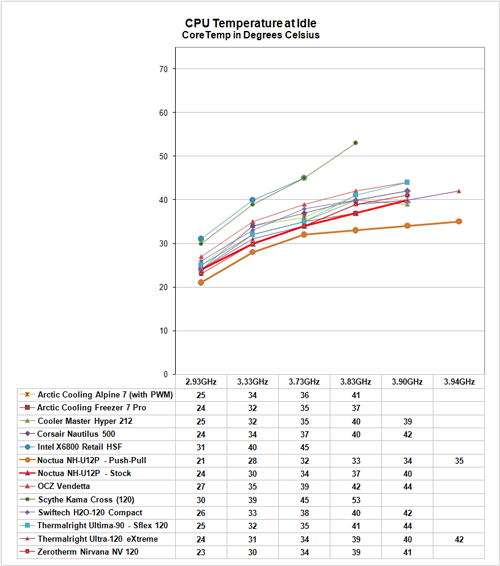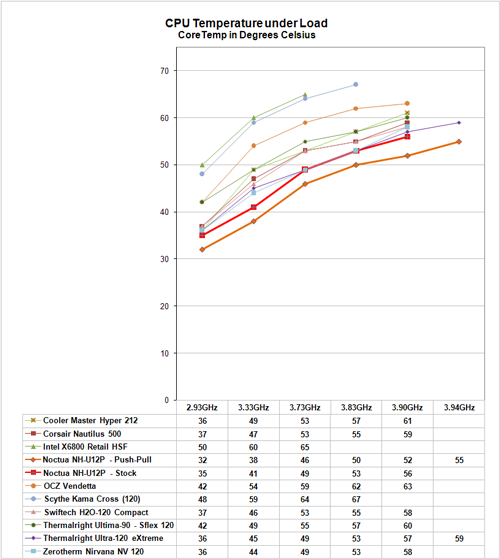Noctua NH-U12P: Top Performance AND Silence
by Wesley Fink on March 20, 2008 8:00 PM EST- Posted in
- Cases/Cooling/PSUs
Overclocking and Performance Scaling
With outstanding performance at stock speed, we pushed the Noctua NH-U12P in our performance scaling tests to see if this air-cooler delivers similarly impressive performance when pushed hard in overclocking. As cooling solutions do a better job of keeping the CPU at a lower temperature, it is reasonable to expect the overclocking capabilities of the CPU will increase. In each test of a cooler, we measure the highest stable overclock of a standard X6800 processor under the following conditions:
CPU
Multiplier: 11x (Stock 11x)
CPU Strap: 266 (stock) or 333 (overclocked)
CPU voltage: 1.5875V at max overclock
NB Voltage: 1.70V
FSB Voltage: 1.40V
SB Voltage: 1.20V
Memory is set to Auto timings on the P35. This removes memory as any kind of impediment to the maximum stable overclock. As FSB is raised the linked memory speed increases in proportion. For this reason, we maintain memory speed as close as possible to CPU strap settings to prevent memory becoming an issue in CPU testing. This means 3.33GHz uses a 333 strap and runs 10x333, 3.73GHz uses a 333 strap and runs 11x339, and 3.90GHz is a 333 strap and 354x11. The stock speed test is a 266 strap and 11x266. We may move in the future to a 3.0GHz stock speed with a 333 strap and 9x333 settings for complete consistency, but since we are not measuring raw computer performance in our cooling benchmarking this becomes a moot point. The same processor is used in all cooling tests to ensure comparable results.

The stock single-fan Noctua reaches 3.91GHz in our overclocking tests, a result exceeded only by our top Thermalright Ultra-120 eXtreme. Even more impressive is the performance achieved when we use two NF-12P fans in a push-pull arrangement, with a top overclock of 3.94GHz. This matches the Thermalright Ultra120 eXtreme as the best air-cooler ever tested at AnandTech.
This superb overclocking performance combines with silent operation, with noise floors below our quiet system level. Noctua appears to have developed a cooler that combines top performance with incredibly low system noise. With the Noctua kit and the NF-P12 fan, you no longer have to choose between top performance or lowest noise. The NH-U12P can give you both - even if you add a second NF-12P fan in push-pull for ultimate cooling.
Performance Scaling
Performance scaling charts for the Noctua NH-U12P use a scale with zero on the bottom and 75C on the top. Keep in mind that the lower line is the best performance in this presentation of the data - lower temperatures represent better performance.
 |
The NH-U12P performance scaling at idle is impressive. It is all but a mirror image of the superb Thermalright Ultra-120 eXtreme running a Scythe S-FLEX fan. When we add a second NF-P12 fan in a push-pull setup, the Noctua is in a class by itself. Temperatures drop another 3C or so and the performance curve is all but flat from 3.73GHz to the top speed of 3.94GHz. If you recall from past test results, a flat curve (shallower slope) indicates a cooler is still in its effective cooling range.
Next, we compare cooling efficiency of the Noctua NH-U12P under load conditions to the retail HSF and other recently retested CPU coolers. Load testing can be very revealing of a cooler's efficiency. Again, we like to see a relatively flat line, which often means we are at the limits of our CPU rather than the coolers. A line with a steep slope indicates a cooler is nearing the end of its ability to cool effectively.
 |
Under load test conditions, the stock NH-U12P again matches the top Thermalright. The single-fan NH-U12P tops out at 3.91GHz while the Ultra-120 eXtreme continues on to 3.94GHz. Temperatures under load at tested speeds are all but the same in faster speeds, while at lower speeds the NH-U12P is actually a bit better performer. These results are very impressive.
Adding a second fan in push-pull again creates a new performance class with the Noctua NH-U12P. Cooling on average is 2C to 3C better than our previous top performer. That may sound like a small amount, but in cooling this difference is significant. With two fans, the Noctua extends to 3.94GHz and sets a new record for best cooling performance at the highest speed we have been able to achieve in air-cooling with this CPU.










51 Comments
View All Comments
Wesley Fink - Friday, March 21, 2008 - link
We covered the Thermalright question head on in the Final Words. The Thermalright is not really set up for push-pull fans so you have to jury rig to get two fans on the cooler. We stated clearly the Thermalright would likely outperform the Noctua with the same fan, but if you wanted to conveniently mount two fans the Noctua was a better choice. Several readers have detailed instructions in the comments on how to mount two fans on the U120 eXtreme with Zip Ties.BTW we have tested every heatsink that was setup for multi-fans with both single and push-pull configurations, so your comment is not fair or accurate. The Thermalright is not really set up for two fans and you end up ripping open the fan wire holders if you try to force two fans. That is why people resort to jury-rigging and Zip ties. We hope Thermalright will address this in the near future as the Thermalright could othwerwise easily mount push-pull fans.
poohbear - Saturday, March 22, 2008 - link
oh ok, i dont recall reading that part of the article, my bad. yea if Thermalright isnt setup for a push/pull config from the factory, it wouldnt make sense to start making customizations just to accomodate it. cheers though.Mr Perfect - Friday, March 21, 2008 - link
At first I was little taken back by the airflow numbers of the fan, but then I noticed they where reporting in Cubic Meters Per Hour instead of the normal Cubic Feet Per Minute. Do you have CFM numbers so this fan can be compared to other fans on the market?Air Flow 92.3/78.5/63.4 cubic meters/hour (1300 stock/1100 LNA/900 ULNA)
poohbear - Friday, March 21, 2008 - link
its 54cfm @ 1300rpm.1 foot = 0.3048 metres; therefore
1 cubic foot = 0.3048*0.3048*0.3048 cubic metres = 0.028316846 cubic metres
and
1 hour = 60 minutes
therefore 1 m3/h = 0.5885778 cfm
hence 92 m3/h * 0.5885778 = 54.1491576 cfm
cheers.
JarredWalton - Friday, March 21, 2008 - link
Some simple math should suffice....1 cubic meter = 35.31467 cubic feet
60 minutes per hour
That gives 54.326/46.203/37.316 CFM, assuming they didn't just put in the wrong abbreviation.
Mr Perfect - Saturday, March 22, 2008 - link
Those numbers make much more sense. Other ~1000RPM 120mm fans also push in the 36ish CFM range.I was hoping Anandtech would put the CFM numbers in the article, it could be misleading if readers don't notice that the rates are not listed in the standard measurement. Anyone who buys a whole bunch of these $21 fans because they think they're putting out 63.4CFM at 900RPM and 12dba is going to be upset.
Baked - Friday, March 21, 2008 - link
If you're not overclocking, Freezer 7 Pro should be the no brainer HSF of choice.Baked - Friday, March 21, 2008 - link
Why bother wasting all that money on trivial performance gain. Just get the Freezer 7 Pro and be done with. Oh wait, I forgot about the epeen factor.poohbear - Saturday, March 22, 2008 - link
freezer pro 7 won't give u a 50%-70% overclock. a 70% overclock is hardly trivial, this is'nt video card overclocking wherein people usually get a 10%-15%.Basilisk - Saturday, March 22, 2008 - link
"freezer pro 7 won't give u a 50%-70% overclock"What am I missing here? As I read the charts in this article, the best listed cooler gave 34% OC on this CPU, while the AFP7 gave 31%. Maybe I'm missing the obvious; or are you reporting un-cited data?
My instinct was the same as others: the AFP7's the better performance/$$ unit, although this new kid has a slight upper end edge.
Not that I don't appreciate the fan improvements. My instinct is there are several further improvements to reduce flow turbulence [noise/efficiency], but we don't see much change in fans.